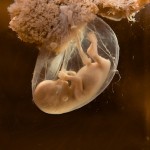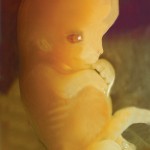Using her deceased husband’s frozen sperm, Karen Capato conceived twins through in vitro fertilization and gave birth to them eighteen months after his death. The Supreme Court of the United States then ruled in a unanimous decision that her twins would not be eligible to receive his Social Security benefits under the intestacy laws of Florida because they were conceived after their father’s death.
Reread that carefully. Did you catch it? Conceived. Although the definition of “conceived” as used by the Court is ambiguous (regarding fertilization or implantation), this is not the typical language used by the Court when determining financial eligibility for pre-born human beings whose most basic right to life is not yet protected by the laws of this country.
Although the oral arguments and opinion of Astrue v. Capato mainly deal with the tautological definition of “child” under the Social Security Act as amended in 1939, the Court overturned the Third Circuit Court of Appeals ruling and upheld the provision of the Social Security Act, citing Section 416(h)(2)(A): “In determining whether an applicant is the child … of [an] insured individual for the purpose of this subchapter,” the Commissioner shall apply state intestacy law. In Florida, this means that children conceived posthumously are not eligible to receive Social Security benefits. According to the legal definition of “child” presented in this case by the SSA, the Capato twins were not considered “children” eligible to receive benefits because they were conceived after the death of their father. So, following this line of logic, if they were conceived before their father died, they would be considered “children” by definition of the SSA. The Court did not correct the definition or change it to the twins’ needing to be “viable” or “born” before their father’s death in order to be eligible – the only stipulation barring them was when they were conceived.
So what does “conception” mean to the Court, anyway?
Regardless of the outcome of the case, the use of the word “conception” is a subtle yet remarkable admission. One little word that means so much: conception – not the former precedential language of “point of viability,” not “birth,” but the point at which a new and unique individual (or in this case two unique individuals) were created.
Now wait a minute – according to the Court, I thought a zygote/embryo/fetus was just a clump of cells or a blob of tissue up until “viability” and wasn’t considered a person protected under the Fourteenth Amendment until birth – but now the Supreme Court is telling us that the moment a “blob of cells” is conceived, it may be eligible to receive Social Security benefits? Okay, so a clump of cells can receive Social Security benefits, but a 12-week-old fetus does not have the right to its life…I got it. Wait…huh?!
The majority opinion by Justice Ruth Bader Ginsburg is potentially (and inadvertently) a huge victory in the courtroom for pro-lifers across America. Since Roe, numerous decisions have been passed down upholding the “constitutionality” of abortion due to the fact the unborn are not being considered persons until birth (or “viability”) and are therefore not protected by the laws of our country under the Fourteenth Amendment. Numerous battles have been fought in the country’s highest Court to overturn the most controversial ruling in our nation’s history and recognize the inherent right to life of the unborn. Time after time, however, the Supreme Court used cases such as Akron v. Akron Center for Reproductive Health (1982), Webster v. Reproductive Health Services (1989), and Planned Parenthood of South Eastern Pennsylvania v. Casey (1994) to vehemently uphold their decision in Roe:
1. Consideration of the fundamental constitutional question resolved by Roe v.Wade, 410 U.S. 113, principles of institutional integrity, and the rule of stare decisis require that Roe‘s essential holding be retained and reaffirmed as to each of its three parts: (1) a recognition of a woman’s right to choose to have an abortion before fetal viability and to obtain it without undue interference from the State, whose previability interests are not strong enough to support an abortion prohibition or the imposition of substantial obstacles to the woman’s effective right to elect the procedure; (2) a confirmation of the State’s power to restrict abortions after viability, if the law contains exceptions for pregnancies endangering a woman’s life or health; and (3) the principle that the State has legitimate interests from the outset of the pregnancy in protecting the health of the woman and the life of the fetus that may become a child. Pp. 1-27.
-Justice O’Connor in the majority opinion of Planned Parenthood v. Casey (emphasis mine)
This decision also brings us to an interesting point of contention that the Supreme Court will assuredly have to face as they embark down a treacherous slippery slope, as more and more cases challenge the (lack of) reasoning behind legalized abortion, particularly with the advancements in scientific technology showing the humanity of the unborn. In attempting to understand the logic behind the language of the abortion precedent in light of Astrue, why does it matter what date the children were conceived in relation to their father’s death if they are not “alive” (according to the Court’s definition) until viability anyway? If the unborn are not entitled to their right to life if it
interferes with a woman’s right to choose, why didn’t the Court use its previously established language of date of “viability” or “birth” to determine the outcome of this case? Is the Court finally realizing that when conception occurs, it is not just a “clump of cells,” but the creation of a unique new human being? Could Astrue be the dawning of a new era in our nation’s courtroom? What are the future implications from this sudden change of diction and break from the stare decisis interpretation by the Court?
Through the Court’s admission of date of conception being vital (no pun intended) in determining eligibility for Social Security benefits, we as a country have taken “one small step” in the courtroom that could be the precursor to “one giant leap” for the unborn and recognition of their intrinsic right to life and personhood. In the majority opinion of Roe, even Justice Blackmun ceded that “[i]f this suggestion of personhood is established, the [Roe vs. Wade] case, of course, collapses, for the fetus’ right to life would then be guaranteed specifically by the [Fourteenth] Amendment.”
Well, Justice Blackmun, I don’t think that “non-personhood persons” can receive Social Security benefits, but according to the very Court you were a part of 39 years ago, simply being conceived is all it takes.
I hope to be a part of the generation that makes your admission become a reality, and with the help of your fellow successive justices, we are on the road to doing just that.









